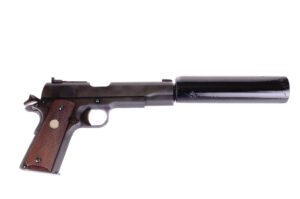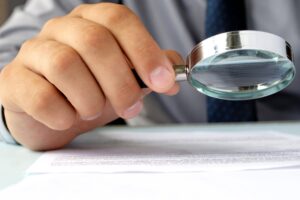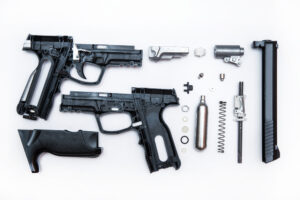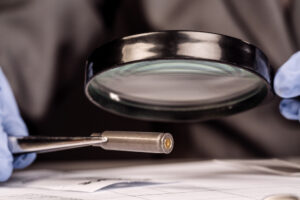SHARING WRITERS RESEARCH FROM MY LAST POLICE PROCEDURAL – GUN SILENCER
WHAT IS A GUN SILENCER?
 A gun silencer, also known as a suppressor, is a muzzle device that reduces the sound of a gunshot. It does this by slowing down and cooling the expanding gases that are released from the barrel when the gun is fired. Silencers do not completely silence a gunshot, but they can reduce the sound level by 20 to 30 decibels. This can make a significant difference in the loudness of the gunshot, making it much less noticeable to people nearby.
A gun silencer, also known as a suppressor, is a muzzle device that reduces the sound of a gunshot. It does this by slowing down and cooling the expanding gases that are released from the barrel when the gun is fired. Silencers do not completely silence a gunshot, but they can reduce the sound level by 20 to 30 decibels. This can make a significant difference in the loudness of the gunshot, making it much less noticeable to people nearby.
Silencers are legal to own and use in most countries, but there are some restrictions. In the United States, for example, silencers are regulated by the National Firearms Act (NFA). This means that you need to obtain a special permit to own a silencer.
COPS AND DETECTIVES USE BALLISTIC REPORTS
 A ballistic report is a record of the characteristics of a bullet, such as its caliber, weight, and velocity. Ballistic reports are used by law enforcement to identify the type of gun that was used in a crime. They can also be used to determine the range from which a shot was fired.
A ballistic report is a record of the characteristics of a bullet, such as its caliber, weight, and velocity. Ballistic reports are used by law enforcement to identify the type of gun that was used in a crime. They can also be used to determine the range from which a shot was fired.
Ballistic reports are created by firing a bullet into a calibrated target. The target is then measured to determine the bullet’s caliber, weight, and velocity. The results of these measurements are then recorded in a ballistic report.
TERMINOLOGY USED BY POLICE OFFICERS AND DETECTIVES:
 Here are some of the terms that are commonly used in the field of gun silencers and ballistics:
Here are some of the terms that are commonly used in the field of gun silencers and ballistics:
- Muzzle blast: The sound and flash that is created when a gun is fired.
- Muzzle velocity: The speed of the bullet as it leaves the barrel of the gun.
- Suppressor efficiency: The percentage of sound that is reduced by a silencer.
- Ballistic coefficient: A measure of the ability of a bullet to resist wind resistance.
- Trajectory: The path that a bullet takes through the air.
- Effective range: The maximum distance at which a bullet can still be effective.
HOW DOES A SILENCER WORK?
 A silencer can leave markings on a bullet. These markings are called “tool marks” and they are caused by the rough interior surface of the silencer rubbing against the bullet as it passes through. The tool marks can be microscopic or macroscopic, depending on the type of silencer and the type of bullet.
A silencer can leave markings on a bullet. These markings are called “tool marks” and they are caused by the rough interior surface of the silencer rubbing against the bullet as it passes through. The tool marks can be microscopic or macroscopic, depending on the type of silencer and the type of bullet.
The markings left by a silencer can vary depending on the type of silencer and the type of bullet.
The markings can be faint or difficult to see, so it is important for ballistics experts to have experience in examining silencer-fired bullets.
The markings left by a silencer are not always unique, so it is possible for two different silencers to leave the same markings.
Overall, the markings left by a silencer can be a valuable tool for ballistics experts. However, it is important to remember that these markings are not always conclusive and that other factors, such as the condition of the gun and the bullet, can also affect the markings.
HOW DO BALLISTICS EXPERTS AND REPORTS WORK?
 Ballistics experts can use these tool marks to identify the silencer that was used in a shooting. They can also use the tool marks to determine the distance from which the shot was fired.
Ballistics experts can use these tool marks to identify the silencer that was used in a shooting. They can also use the tool marks to determine the distance from which the shot was fired.
In addition to tool marks, silencers can also leave other markings on bullets. These markings can include:
- Rifling marks: If the bullet was fired from a rifled gun, the silencer can leave rifling marks on the bullet. These marks are caused by the grooves in the barrel of the gun.
- Gas pitting: The gas that escapes from the silencer can pit the surface of the bullet. This pitting can be seen under a microscope.
Lead fouling: The lead from the bullet can foul the interior of the silencer. This fouling can also be seen under a microscope. - Ballistics experts can use all of this information to determine if a bullet was fired through a silencer and, if so, what type of silencer was used. This information can be very helpful in solving crimes.
- Here are some additional things to keep in mind:
